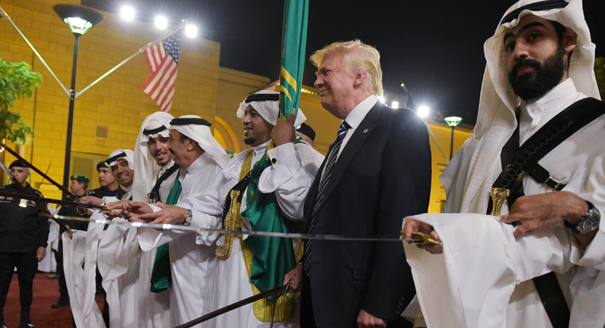Patrick Tyler | Former journalist at the Washington Post, then the New York Times, author of A World of Trouble: The White House and the Middle East—from the Cold War to the War on Terror and Fortress Israel: The Inside Story of the Military Elite Who Run the Country—and Why They Can't Make Peace
American power has been the story in the Middle East since the close of World War II. No challenge from the Soviet Union, followed by Russia, Saddam Hussein, Ayatollah Ruhollah Khomeini, Osama bin Laden, or the Islamic State has been able to change this. Yet changing domestic politics in the United States is eroding the unstinting moral commitment to peace and justice in the Holy Land.
Former president Barack Obama’s idealism raised new expectations for peace, but he was unable to muster a political majority to execute anything beyond consensus military operations unrelated to the peace agenda, thus weakening U.S. power and influence. President Donald Trump has embraced an Israel-centric policy that courts the Sunni Arab leadership in a military-based approach to Iran and the spectrum of Islamic militants.
The foundation of American power is rapidly shifting. Hard military power is on the ascendant while the principles underlying U.S. diplomacy since 1949 have lost their political base.
Hussein Ibish | Senior resident scholar at the Arab Gulf States Institute in Washington, D.C.
By most objective metrics, U.S. hard power (military), soft power (scientific, cultural, and humanitarian), and “sticky” power (economic) in the Middle East is largely unchanged from four or eight years ago. Washington is still the predominant outside force in the region, and, arguably, the single most influential player in the region.
However, American leverage has been declining in recent years due to a combination of factors: U.S. reticence to use military force; a concomitant rise of regional powers, such as Iran, and the return of Russia as a Middle Eastern player; and a perception that American leadership has been ineffective—whether in Iraq and Syria, in containing Iran, and even in mediating an Israeli-Palestinian peace settlement.
The Trump administration has repaired frayed ties with traditional partners such as Israel and Saudi Arabia, and adopted a tougher rhetorical stance against Iran’s destabilizing activities. But it has yet to do anything substantial to dispel the widespread impression that American power is gradually and irretrievably declining both globally and in the Middle East. Therefore, U.S. power today is, at best, comparable to that during the Obama administration, and arguably has continued a slow but steady deterioration that began after the invasion of Iraq.
Salim Yaqub | Professor of history at University of California, Santa Barbara, author of Containing Arab Nationalism: The Eisenhower Doctrine and the Middle East (2004) and Imperfect Strangers: Americans, Arabs, and U.S.-Middle East Relations in the 1970s (2016)
Barack Obama built a sandcastle at the edge of a swelling tide. As the waters rose, he dug moats around the castle walls. These slowed, but could not stop, the erosion of his handiwork. “Why am I even bothering?” he thought to himself. “This is lousy sand for castle-building anyway.” And then, of course, it was time for him to go. Donald Trump strutted onto the beach, snorted at his predecessor’s creation, and started kicking at the high towers. But most of his kicks struck nothing but air, and the ones that landed did only modest damage. He soon tired of the effort and wandered off to find his phone. The tide poured into the neglected, vanishing moats and began lapping more vigorously at the castle walls. “Obama left a HUGE mess for me in the Middle East,” the president instructed his 47.8 million Twitter followers. “It should have been fixed Years Ago but now it’s too late. Sad!”
Perry Cammack | Fellow in the Middle East program at the Carnegie Endowment for International Peace, former member of the Policy Planning Staff at the State Department under secretary of state John Kerry (2013–2105), where he worked on Middle East-related issues
Earlier this month, despite a growing American economy, low unemployment, and low inflation, the Dow Jones Industrial Average shed more than 2,300 points, its sharpest five-day nominal decline ever. No one can say why. However, successful investors understand that, contrary to academic orthodoxy, market sentiment and economic fundamentals can diverge sharply.
Political scientist Samuel Huntington considered power to have six components: economic, military, diplomatic, ideological, technological, and cultural. In most of these categories, American power in the Middle East remains preeminent. But perhaps Huntington should have added a seventh. For in world politics, as in financial markets, power is a mysterious blend of objective reality and animal spirits.
Beset by scandal and incompetence, the Trump administration has struggled to articulate a coherent approach to the Middle East. But America’s travails in the region hardly began in 2017. The Obama administration, too, struggled to respond effectively to crises in Syria, Egypt, and elsewhere, as longstanding security partnerships frayed. In retrospect, April 2003, when U.S. tanks triumphantly rolled into Baghdad, marked the apex of Washington’s regional influence. In the fifteen years since, the United States has whiplashed between hot interventionism and cold retrenchment, with little success either way.
Time will tell if sentiment and fundamentals will again converge.








